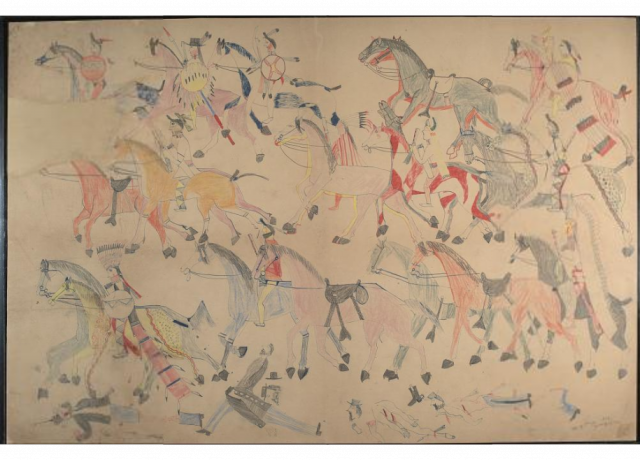 Red Horse pictographic account of the Battle of the Little Bighorn, 1881
Red Horse pictographic account of the Battle of the Little Bighorn, 1881Posted on 01/21/2019 12:17:14 AM PST by vannrox
In most cases, movies based on real incidents tend to make those events more exciting. Not so in the case of Custer’s Last Stand. Of course, moviegoers wouldn’t likely want to see all of the scalping, animal killing, decapitation and other grim horrors of this battle.
There would not be enough time in these movies to allow for the minor but still intriguing facts surrounding Little Big Horn.
These facts and/or believed stories are well worth to read!
The Cavalry, armed with single shot carbines was no match against Native Americans with far more firepower. They were up against 100 repeating Winchesters and more Indian firearms numbering as many as 350 total. It was an onslaught they were unprepared for.
These Cavalry soldiers were possibly not all well trained. There were several minors that were not yet of military age among them, and several of the men found in archeological excavations were not in military uniform. Indian accounts of the battle describe the men as scared and in a panic.
By most accounts, many of the men ran away from the carnage to make defense farther up, and it was on Custer Hill that Lt. Edward Godfrey and General Edward McClerand (and later confirmed by archeologists) found the bodies of Cavalry men surrounded by a circle of dead horses.
“On top of Custer Hill was a circle of dead horses with a 30-foot diameter, which was not badly formed. Around Custer some 30 or 40 men had fallen, some of whom had evidently used their horses as breastworks.” – General McClerand
“Numerous dead horses were lying along the southwestern slope of Custer Hill. On the very top were found four or five dead horses that were swollen, putrid, and offensive, their stiffened legs sticking straight out from their bodies. Close under the brow of the hill several horses are lying together, and by the side of one of these Custer was found.” – Colonel John Gibbon
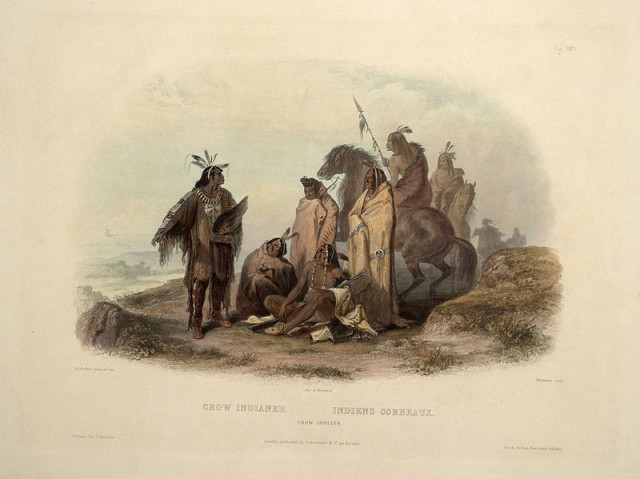 Crow indians
Crow indiansCrow Chief Plenty Coups had a vision as a child that if his nation was to survive, it would need to befriend the coming white man. He stuck to that his entire life, and upon his death in the 1920s; he donated his home to the National Park Service.
The Crow were originally from Lake Erie, but in the 1700s were pushed Westward by other tribes to first Manitoba, and then by the Cheyenne and Sioux into Montana. The Crow territory included Little Big Horn, and in 1851, that land was included in the reservation boundaries set by the U.S. government for the Crow nation.
For decades, nearly a century, before the formation of the Crow reservation and the Crow’s alliance with the U.S., the Cheyenne, and Sioux had been stealing Crow horses and warring with the less armed nation on a regular basis. They were, in a sense, bullies.
In 1868, after battling with the Sioux, the U.S. signed the Treaty of Fort Laramie, which gave the Lakota Sioux territory up to the crest of the Bighorn Mountains. The Sioux treatment of the Crow became worse, and in the two years leading up to the battle with Custer, it escalated and it further involved the U.S. Army.
The Crow did not have enough numbers to defend themselves and neither did the Army, but together they were better off. Sioux made numerous raids on the Crow and Army outposts, and the Crow would often sacrifice their warriors in attempts to recover stolen horses and goods.
Indian Agent Dexter Clapp began to plead with the government for assistance in helping the Crow. He said, “As long as they are being driven from point to point, there is no use asking them to settle down and farm.” Clapp himself, in the meantime, armed the Crow with guns and ammunition. “The Sioux are now occupying the eastern and best portion of their reservation, and by their constant warfare, paralyzing all efforts to induce the Crows to undertake agriculture.”
It wasn’t only the Crow that were being pushed around by the Sioux; other nations included Shoshone, Blackfeet, and Arikaras.
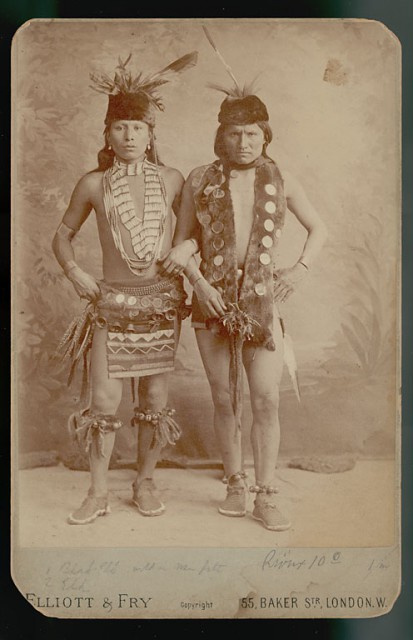 Black Elk and Elk – Oglala Lakota
Black Elk and Elk – Oglala LakotaDuring the battle, in addition to scalps, the Sioux took things from the soldier’s bodies that intrigued them.
Watches were seen only as an object that ticked, and once the ticking stopped, they were mostly discarded. Black Elk says of one that he took from a soldier’s belt “It was round and bright and yellow and very beautiful, and I put it on me for a necklace. At first, it ticked inside and then it did not anymore.”
They also found compasses and saw that the needle floated and moved when the compass case was turned. Because of their position to the bodies of the dead soldiers, the compass happened to point at the bodies. They concluded that the device was attuned to the soldiers, and that’s how the white men found each other.
Paper money was of no use as it was seen as green art and was given to the children or thrown away. The wallets, however, were worth more and were kept – an interesting and opposite perspective than ours, but probably more correct.
The Warriors also found flasks. They assumed the strong, burning liquid inside was “holy water” and that it was this drink that made the soldiers act strangely – shooting at each other and committing suicide in panic.
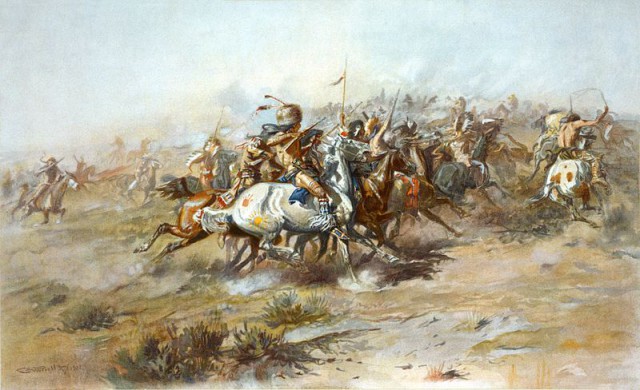 Battle of Little Bighorn
Battle of Little BighornAfter Custer himself fell, the remaining soldiers fled in a disorganized panic toward a stand of cottonwood. The stampede was such that an Indian warrior compared it with a “hunting buffalo”.
“The white men went crazy. Instead of shooting us, they turned their guns upon themselves. Almost before we could get to them, every one of them was dead. They killed themselves.” – Wooden Leg
“More and more soldiers were getting off their horses, preferring to hide or crawl along the ground . . . As hundreds of Indians surrounded this ridge, I saw one of the soldiers point his pistol at his head and pull the trigger. Others imitated his example, sometimes shooting themselves, sometimes each other. When Chief Lame White Man reached the soldiers, all of them were already dead. Indians then attacked the first ridge, and again, most of the white men were already dead. The only thing remaining for the Indians to do was pick up the abandoned guns and ammunition.” – Kate Bighead
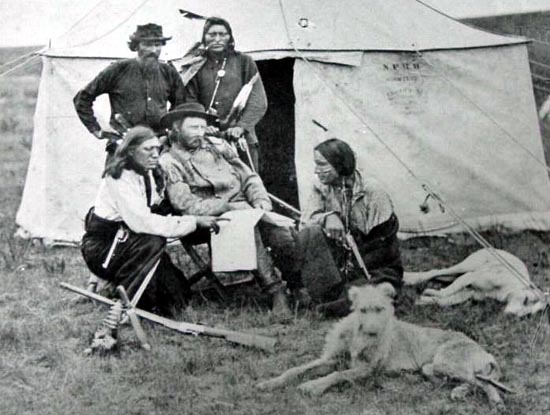 Custer and his dogs with Crow Scouts
Custer and his dogs with Crow ScoutsThere were, of course, horses at Little Big Horn, but there were also other animals – pets among them.
Custer wrote home to his wife “Tuck regularly comes when I am writing, and lays her head on the desk, rooting up my hand with her long nose until I consent to stop and notice her. She and Swift, Lady and Kaiser sleep in my tent.” His dogs were trained to run alongside his horse that could be how Tuck died in the battle. The other dogs had been left at camp with their caretaker.
The horses have far stranger stories. Aside from the trench of horses mentioned above, there were mysterious horses like Little Soldier, the horse of Bobtailed Bull, an Arikara scout working with Major Marcus Reno. After Bobtailed Bull had died in battle, Little Soldier made his way over 300 miles back to his home in the Dakota Territory.
Another horse was found by General Godfrey on the Yellowstone River. It was missing nothing. It had its halter, saddle, and bit – everything down to the oats to feed it. The saddle bags were empty, but the general was told that they did hold a carbine when first discovered. The horse had been shot in the forehead. There was no sign of the rider.
A horse that showed up in Canada after its sale by the Sioux was recovered by the Mounties, and after U.S. approval, the RMP superintendent, James Morrow Walsh was allowed to keep it. He named him “Custer”.
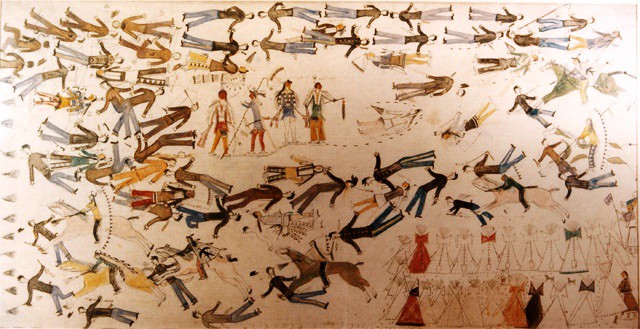 Battle of Greasy Grass
Battle of Greasy GrassThere are several paintings of the battle done by Indians, the most famous of which was done by Kicking Bear, a Sioux warrior and a later performer in Buffalo Bill Cody’s Wild West show. From his perspective, the central focus is himself, Crazy Horse, Rain In The Face, and Sitting Bull. It also features Custer and the departing spirits of the deceased. Red Horse pictographic account of the Battle of the Little Bighorn, 1881
Red Horse pictographic account of the Battle of the Little Bighorn, 1881
Red Cloud also shared his perspective in a pictograph.
Captain Grant Marsh of the Far West Steamboat was the first to deliver the news of what happened at Custer’s Last Stand. His mission had been to take supplies to Custer, but instead, he ferried 51 wounded soldiers away from the massacre.
To do this, he had to drop some weight. Rather than drop the fuel needed for steam, or supplies needed for the men, he chose to drop $375,000 worth of gold bars on the shores of the Bighorn River. It has never been recovered.
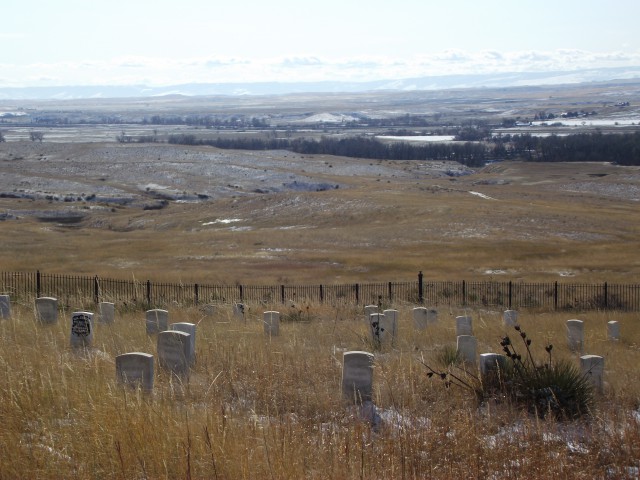 Little Bighorn Battlefield National Monument Montana. By 1025wil CC BY-SA 3.0
Little Bighorn Battlefield National Monument Montana. By 1025wil CC BY-SA 3.0If you visit the battlefield at Little Big Horn, there is a visual cue for gaining perspective on how the battle went down.
Each marble marker marks the spot where a soldier fell. Originally, they were buried where they died, but the bodies were moved later. The markers remain.
The places where the soldiers fell are marked with white marble headstones, so from afar you can get a picture of what the aftermath looked like.
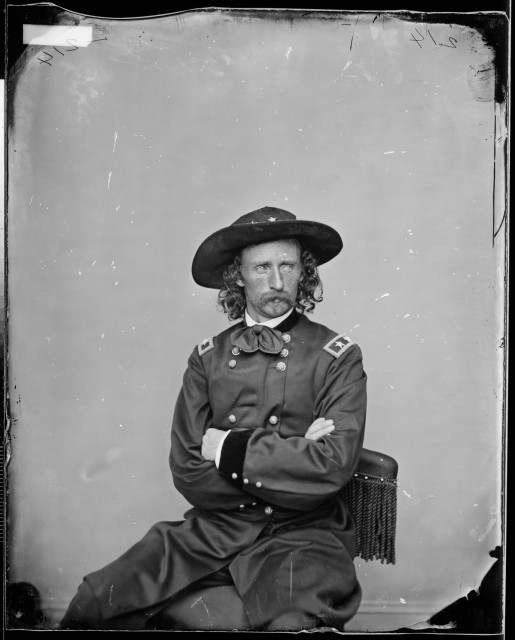 Gen. George A. Custer
Gen. George A. CusterCuster’s life is a mishmash of failure, brazen luck, and some success, but he wasn’t the hero or anti-hero portrayed in movies.
He was known as a prankster at West Point and graduated as the lowest ranking cadet.
Most people believe he was a general, and he was for a while during the Civil War – a Brevet Major General. After the war, the rank reverted to Captain and remained so for the rest of his career.
He was court martialed twice – once for going AWOL to visit his wife.
During a campaign in Texas, the soldiers continually gave him gruff and balked at his discipline, and thought of him as a “vain dandy.” Custer was known for his appreciation of his hair and his attention to it with cinnamon oil for scent and other treatments.
Most of the legend surrounding Custer was embellished or even made up by Custer’s wife during speeches throughout her life, and by the shows put on by a friend and fellow soldier, Buffalo Bill.
It’s amazing what modern archeology and good investigation can accomplish.
Studies underway at Little Big Horn Battlefield National Monument are so advanced that researchers can find a bullet on the ground and track where it was shot from, who shot it, and how adept at fighting the soldier was.
They conduct their research with metal detectors and microscopes and match firing pins to rifle cartridges. They are also working with new translations of Native American accounts of the battle.
BFL

OMG.
I know several Blackfoot and they insist that the plural of Blackfoot is Blackfoot. I have seen the common english plural of Blackfoot used on maps, signs leading up to the res etc... but if tribal members themselves use Blackfoot as the plural than I can only surmise that it is indeed Blackfoot.
By any objective standard George Armstrong Custer was one of the worst men ever to be commissioned an officer in the US Army. Reckless, frequently insubordinate, he cared little if anything for the welfare of his men and he was a serial adulterer to his long suffering wife Libby.
Custer’s widow was a master of fake news, presenting him as a hero and skipping his outright failure. Most people think of him as I did Lincoln and FDR in my ignorant youth. (Unlike my increasingly appreciative understanding of Washington.)
Imagine that. Not a white man among them.
No, it was named after Monsier Carre de Acque, the Marquis de Custard.
Most of Custer's battalion died in, approximately, company formation, in a long skirmish line along the ridge. There is some intermingling as one would expect as a position collapsed, but the location of the bodies does not suggest panicked flight. The greatest degree of intermingling is on the highest elevation, which we know as Last Stand Hill. This makes sense; Custer would have headed for the high ground as things went south, and survivors of other companies would have tried to reach the last group of fighters as their positions were overrun. Custer's body was found on the high ground, although it is often suggested that he may have been killed or severely wounded earlier, down on the ford. We don't really know when or where Custer was hit, and this point still draws conjecture because it is relevant to the conduct of the 7th Cavalry's battle.
The Indian description of panicked flight may be a reference to the Reno fight. Reno had crossed the river with three companies and hit one end of the village while Custer's column moved along the ridge on the far bank. Reno quickly discovered that he had kicked a hornets nest and was fighting the whole Sioux nation, while Custer's men were nowhere to be seen. Reno gave the order to withdraw to the cottonwoods along the river, though in fairness it seems that every man in his command had reached the same conclusion independently; they were running for their lives from a hopeless skirmish line in the open ground back to the cover of the trees. The survivors regrouped in the woods and fell back across the river to a convenient bluff, where they were soon joined by Captain Benteen and his command. This half of the regiment held out until relieved when the Terry-Gibbon column arrived
The subject of cavalry troopers shooting themselves sometimes comes up. Some of them probably did. The Indians routinely practiced torture, and they were good at it. Some gruesome samples were found on the battlefield, including dismembered remains of some men -- three if memory serves --who were unfortunately enough to have lived long enough to be taken back to the village. The principle of saving the last bullet for yourself is found in many armies with experience of fighting natives who liked to finish enemies slowly. As Kipling put it, "When you're wounded and left on Afghanistan's plains …."
It was Reno’s detachment that ran for the trees. Custer was in a completely different part of the battlefield and probably still alive at that point.
“By any objective standard George Armstrong Custer was one of the worst men ever to be commissioned an officer in the US Army”
But I will give him credit for Gettysburg, where his recklessness may have prevented the Southern Cavalry from getting behind the Union army, and cooperating with Picket’s Charge to split the Union army in half.
There is one Indian account of a trooper who, the Indians said, tried to ride for it. If the Indian accounts are correct, this man had actually outdistanced his pursuers and looked to have gotten away when he suddenly pulled up, took out his revolver, and shot himself. The battlefield was searched, however, and no remains consistent with this account have ever been found. If this man got a couple of miles away before shooting himself, his body may have been missed, but we just don't know. It's one of the remaining mysteries of the Custer fight.
Well that was a worthless article.
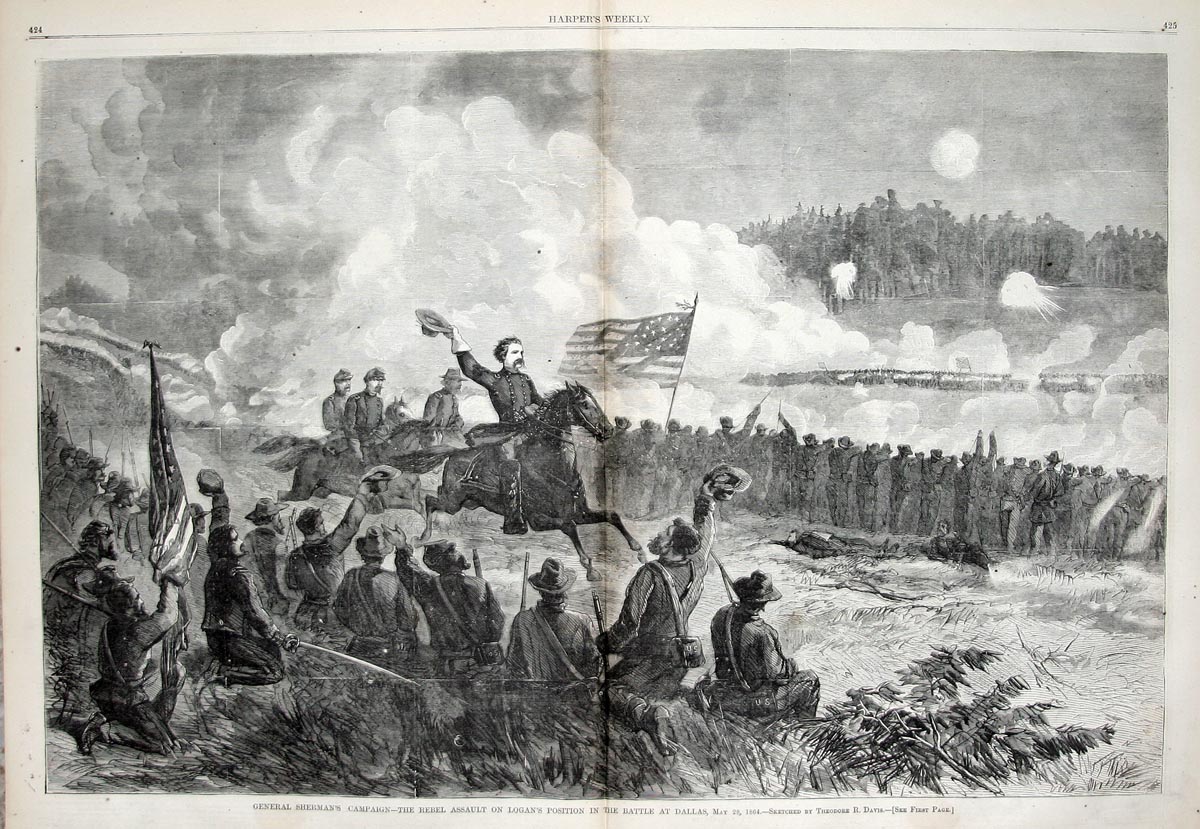
Frank Finkel?
"Days after the disaster, Finkle reached the confluence of the Rosebud and Yellowstone rivers and put his dying horse out of its misery with a single pistol shot to the head. Lieutenant Edward Godfrey of the 7th Cavalry found the horse in August and realized that there had been a survivor."
Survivor Frank Finkel’s Lasting Stand
There is a reason that both sides took things to the extreme. It was a battle for existence in the eyes of many. We have have come a long way from those days, despite the left wanting all of us to relive those battles today.
To hell with them.
"A Fate Worse Than Death" - Stories of captives of Native American Tribes
I believe this is the authors blog, but the book is available on Amazon. I have a copy. It relays the horror of torture in excruciating detail.

Not mentioned is the fact that many of the soldiers under Custer’s command were recent immigrants who did not speak English. They were Polish or from other Eastern European countries.
“The Warriors also found flasks. They assumed the strong, burning liquid inside was “holy water” and that it was this drink that made the soldiers act strangely – shooting at each other and committing suicide in panic.”
I’d bet that by 1876 most Indians knew what alcohol was.
Disclaimer: Opinions posted on Free Republic are those of the individual posters and do not necessarily represent the opinion of Free Republic or its management. All materials posted herein are protected by copyright law and the exemption for fair use of copyrighted works.